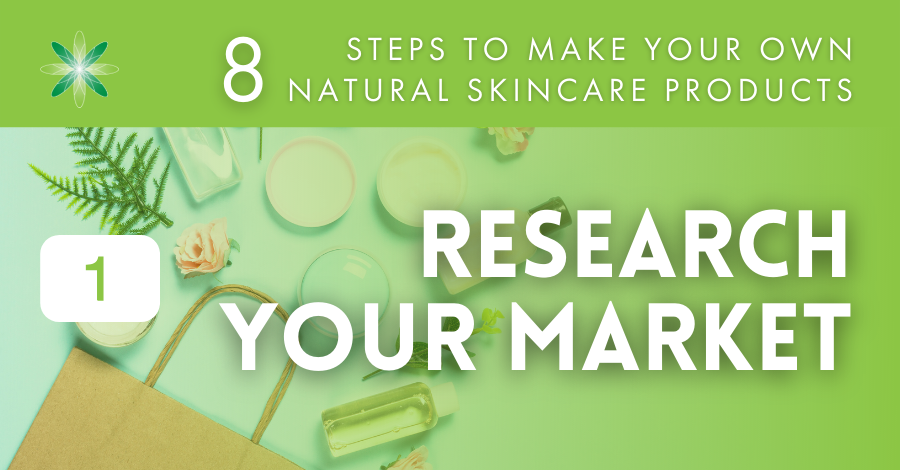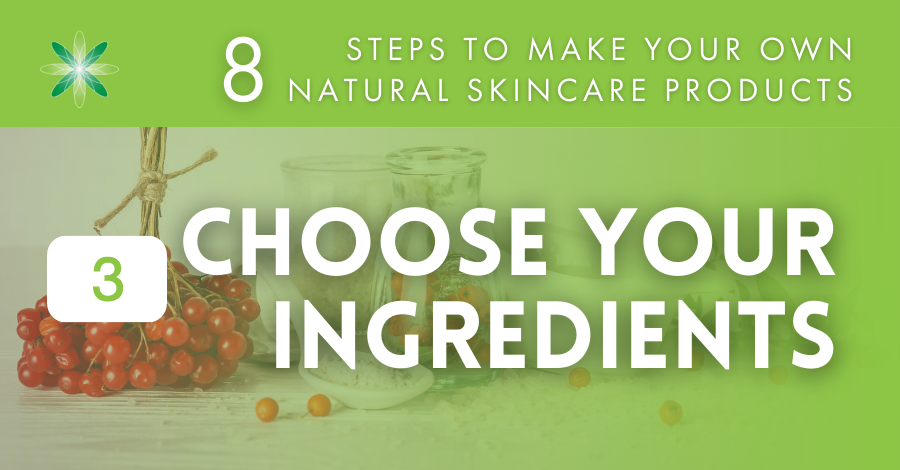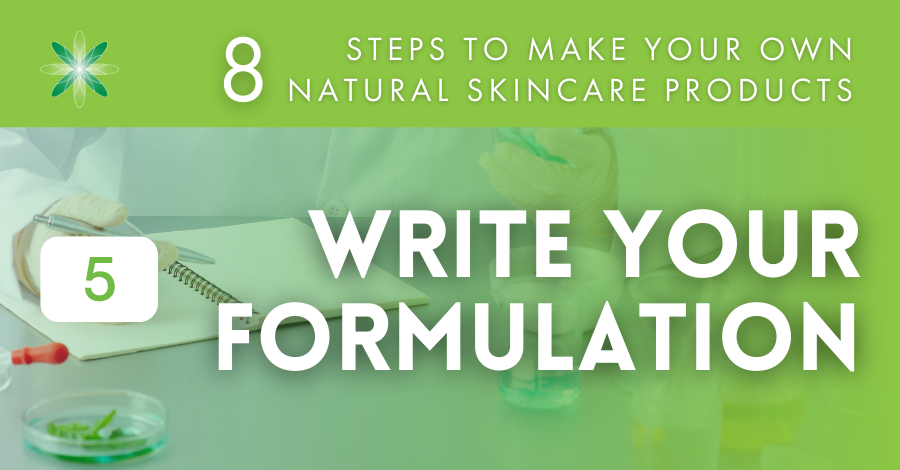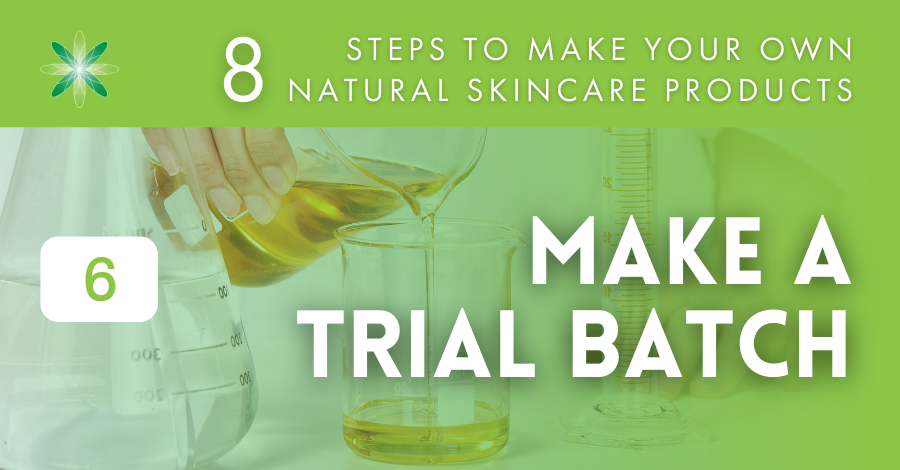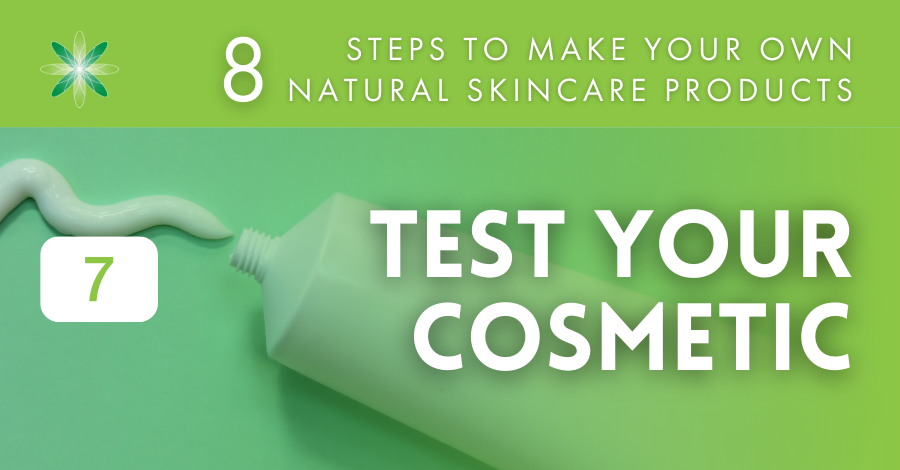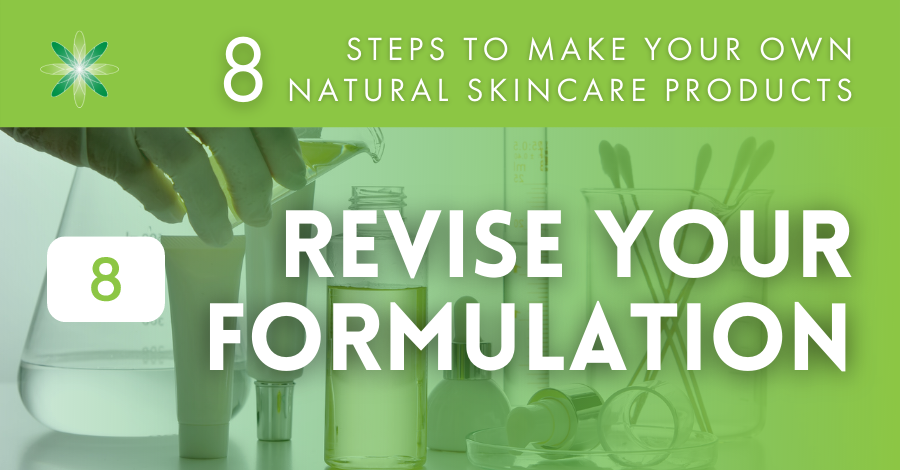If you have been wondering how to make your own skincare products, then this article is the place to start. We run you through the key steps that every formulator takes. Whether indie beauty founder, lab chemist or beginner home formulator, cosmetic product manufacture follows a similar method.
Learning to formulate cosmetics that meet people’s skincare needs is part creative process and part science. It requires time spent in product and ingredient desk research before you even start making cosmetics in your home lab. As a beginner formulator expect also a lot of trial-and-error learning on the job.
However, once you have made your first simple face oil, body butter or eye serum, you realise just how much fun and how empowering making your own homemade skincare is. A whole new world of natural formulation opens up, bringing with it exciting new paths that many of our students and graduates have found life changing.
What’s required
Let’s reassure you at the start that making beauty products is within the reach of everyone. You do not need to be a cosmetic chemist in order to formulate safe, efficacious cosmetic products. Among the hundreds of Formula Botanica graduates we showcase in our online gallery, there are successful indie beauty formulators from all career backgrounds. Nearly all were totally new to cosmetic formulation, but in making their first tentative products they developed a passion for learning more about natural, organic ingredients.
Also, you do not need any expensive, fancy equipment to make skincare products at home. We have identified a list of just 12 key tools beginner formulators need and they are all easy and cheap to buy.
You can easily find a small space in your home to set up as a makeshift lab. Our students have proved inventive in doing this. The video articles below show a variety of lab spaces and also how our students have upscaled their resources over time having started in converted bedrooms and on kitchen surfaces:
Behind the scenes in our students’ labs
Beginner’s guide to setting up a home lab
Benefits of making your own skincare
A main advantage for many indie beauty formulators and brand founders is the freedom they have to explore the cosmetic niches and organic ingredients that appeal to them. A cosmetic chemist employed by a large brand may have less creative freedom as they may need to fulfill a product development brief dictated by the brand’s marketing department.
We know that many of our students and graduates start learning how to formulate skincare as they were unable to find what they needed on the shelves. If you can’t find something to resolve your skincare needs, the chances are others will need the same product too. By creating it, you may have the beginnings of an organic skincare business. We’ve come across at least another seven reasons to inspire you to make your own cosmetics. See our post:
8 reasons to make your own skincare even if there’s plenty to buy
For what to expect making your own skincare, take a look our post a day in the life of a natural formulator in which four Formula Botanica tutors share how they work all the way from researching a new cosmetic product to testing it out.
Now we have set the scene to show that cosmetic formulation is accessible to everyone, almost anywhere, let’s take you through the steps you take to learn how to make skincare products.
8 Steps to making your own skincare
1. Research the market
Your market may be that of your family and friends to start with. Get used to researching what people need help with in their skin care routines and what products they would like to see. We have seen Formula Botanica students and graduates start social media channels as a way to engage with potential customers, to find out about key skincare issues and to act as platform for them to learn and showcase their growing knowledge about natural, organic cosmetics.
If you are thinking about taking cosmetic formulation further, identify at least 10 online beauty and personal care resources that provide industry updates, and of course consumer-facing beauty websites and social channels too. The more you embed yourself in the natural cosmetics’ market, the more you will learn and be able to apply to formulating your own products. Above all, be critical and don’t always take things at face value. As you learn, you will find your voice and be able to identify reputable industry and opinion sources online.
Formula Botanica’s podcast, Green Beauty Conversations, is a mine of balanced information covering the world of green and indie beauty through interviews with influential people in the sector and debate about the latest, often controversial topics around sustainable beauty. Keep up with what’s going on in green beauty before deciding what to formulate. Your best ideas may be sparked by something you watch, listen to or read.
2.Define your product type
Now that you have a sense from your market research for the types of product and ingredients that are trending or that your target market is looking for, you can think about the type of cosmetic product to make. You could focus, for example, on solid formulations, cosmetics containing natural retinol alternatives, or multi-tasking, minimal-waste products in tune with sustainability principles.
Choices like these are fundamental to deciding which ingredients and packaging you choose, how a consumer will use your product and where it will end up. If you are aiming for a sustainable product, you need to have an idea also about your formulation’s afterlife down the sink and the disposal of its packaging.
By making, for example, a powdered cleanser formulation rather than an emulsion or oleogel one, you need to focus on the types of ingredients that can be included – or not – and on the packaging required. With beauty consumers now making purchasing choices based the sustainability and ethical credentials of cosmetics brands, there is far more to think about in defining your cosmetic product type than ever before.
Your product type might be guided by your mission to eliminate packaging, by a star ingredient you want to use, or by your desire to use a particular innovative, biodegradable option such as mushroom packaging. As you can see, defining your product is also about defining your mission, especially if you are planning to start an indie beauty business.
3. Identify and buy key ingredients
Don’t rush into making your first simple cosmetic formulation, however tempting that is and easy the product seems, without getting into the habit of understanding your ingredients. What our students and graduates love about natural formulation is exploring the rich, wonderful world of botanicals and the skincare benefits hidden in their unique properties. Our Formula Botanica tutors explain just how important and well spent their time is on researching ingredients in this article:
Let’s take a simple face oil as an example of ingredient research. You may be using only 5 or so botanical oils, but each oil will have different properties of interest.
Some may be occlusive and better used to protect the skin’s barrier or to reduce trans-epidermal water loss (TEWL). You may choose oils on the basis of their unique lipid profile such as their phytosterols and other compounds of interest such as lipid-soluble antioxidants. Even identifying five botanical oils can lead to hours of research to ensure you choose those offering benefits to your proposed formulation and its target user.
Taking a simple formula and learning how to adjust it is good way to learn cosmetic formulation. We offer ideas and advice on how to research and source natural cosmetic ingredients in these articles:
7 tips on sourcing sustainable ingredients
Organic formulators tell all: finding natural ingredients
Podcast 79: the challenge of sourcing natural ingredients
Podcast 33: sourcing sustainable organic skincare ingredients
See also the 30 articles in our formulator’s guides’ series. We cover in depth numerous functional and trending active ingredients from natural gums, emulsifiers and humectants to CBD extracts, antioxidants, peptides and AHAs/BHAs.
Over time, you will build up knowledge of natural ingredients, how they perform in certain formulations and their synergy with other ingredients. Above all, ask yourself what role an ingredient plays in a formulation. Less is always more in natural formulation.
Our students can access our directory of recommended natural ingredient suppliers. These are companies that can support small-scale formulators who want to buy minimum order quantities or small amounts to use in trial formulations. Our advice is to build relations with trusted, natural cosmetic ingredient suppliers. If you intend to scale up and make cosmetics to sell, ensure your suppliers can provide the required documentation: certificates of analysis; and safety datasheets.
4. Set up your home lab
You can set up a home lab or working space pretty much anywhere when starting out. We’ve seen a Formula Botanica student follow her course using a lab in a suitcase as she traveled a lot for her work. One of our graduates runs her indie beauty business, Boreal Folk, from her mobile camper van.
Ideally, find somewhere quiet and away from the hub of household life. Our tutors talk about first starting in a corner of their kitchen formulating just for a snatched hour or so at a time. Our students create home lab spaces wherever they can as their videos show.
Wherever you set up your home lab space, follow the principles of Good Manufacturing Practice (GMP). GMP might sound like something only large-scale, professional cosmetics labs need worry about. But, in fact, GMP is a series of standards that are common sense guidelines even a home formulator can adhere to. For an overview, see the FDA GMP guidelines for cosmetics.
If you start early on in your cosmetic formulation career learning about GMP, you will be able to create cosmetics in a safe, professional manner. The effort taken now in learning the fundamentals of GMP will save you time later, and give you peace of mind, even if formulating your first cosmetics to gift friends and family.
We have plenty of articles covering how to set up your home lab and follow GMP:
Beginner’s guide to setting up a home lab
How to set up your artisan skincare lab
A day in the life of a natural formulator
Behind the scenes in our students’ labs
8 points you must know before making natural skincare
5. Write your formulation
One of the 12 key formulation tools we mentioned earlier is a notebook in which to write down every formulation, and trials and variations you make, along with your observations on the method used, formulating issues, and of course the product results. What could you do better, how did the formulation work in manufacture, and does it perform on the skin as intended? There is so much you need to document, whether in a physical or virtual notebook, about cosmetic product manufacture.
Imagine you wished to scale up a formulation several months after making the first trials of a product only to find you didn’t put a date or trial/batch number on the winning formulation to cross reference with your notes? Even formulations that went wrong are essential to learning on the job. Trial and error is everything, but without documentation to refer to you will be working blind if you recreate a formulation.
To write down a formulation you need to work in percentages. Never work in drops or a combination of weight and fluid measurements. Cosmetic formulations should be written in percentages but you may not always wish to make large batches of say a nice neat figure of 100g or 100 ounces. In this case, you need to scale down and do the maths.
We cover percentage calculations and weight-to-percentage maths in our foundation Diploma in Organic Skincare Formulation. It is vital to work out the percentages of all your ingredients from a weight-based formula so you can replicate it and scale it up if you need to.
Many DIY skincare recipes on the internet talk about drops of essential oils, for example, or of various spoon sizes for other ingredients. These formulations are best avoided as there is no accurate way for you to replicate them safely. Essential oil drops vary in weight as they have different specific gravities, and rarely would even one drop be the exact weight of another drop even if from the same bottle. We’ve done the experiments to prove this. These articles are useful background on why you need percentage-based formulations:
Top 10 organic formulation questions answered
Why you should never measure essential oils in drops
Take a look at any of the formulations we offer on this site to see how we write them. You will notice that ingredients are listed in phases – A,B,C and so on. This not only shows which ingredients to combine, but also helps explain the method of manufacture.
Gums, for example, are usually blended with the humectant glycerine, or similar, to ensure they are dissolved properly before being blended into an emulsion. Heat-sensitive ingredients like essential oils and natural preservatives are added last in most formulations, in particular in the so-called cool-down phases of emulsion making.
Work out how your ingredients combine, and why and when they are included in the manufacture process. The method of manufacture is as important as the percentage formula as a lot can go wrong if you are not clear about when to combine certain ingredients and phases.
6. Make a trial batch
Armed with your working formula, it’s time to make a first trial batch of your new cosmetic product. Prep your work space or home lab, and ensure you have the tools to hand that you need for the formulation. This article shows you the basic kit you need to make your first formulations:
Make a small batch only, such as 25-100g depending on the type of formulation and the weight of the smallest amount of ingredient added. It may be impractical to make very small trial batches if you are unable to weigh out the minute amounts needed. Most beginner formulators start with cheap pocket or jewellery scales which work to two decimal points and up to around 500g.
Ensure you follow your proposed method, and make notes about any deviations and on your observations. This information is invaluable as it will guide you when you trial the formulation again as you will no doubt make some adjustments to your percentage formula or to your method in order to improve the product outcome.
Most products, especially oleogels, gels, balms and emulsions need time to settle to allow air bubbles to disappear or to cool, so do not expect to assess your final cosmetic product until 24 hours later as a bare minimum. Even cold-blend formulations will thicken over time. This brings us to the next stage in how to make skincare: testing your cosmetic product.
7. Test your cosmetic
You need to test out your homemade skincare yourself to see if it performs as you expected. Assess how it feels on the skin, how it absorbs, its scent, its viscosity and how well it dispenses from your chosen container. These are some of the basic, first tests to perform and to repeat over a few days or weeks.
There are of course more formal, routine tests to carry out on your products which cosmetics labs must undertake on batches intended for the market. Stability and microbial tests are designed to assess the safety of a cosmetic. An emulsion may split, even weeks or months later, and prove unsafe as a result. The preservation system of a cosmetic must be challenge tested to ensure it keeps the cosmetic safe to use as intended. Even anhydrous products may need preservatives if they come into contact with fingers or damp conditions.
While these tests may seem daunting if you are new to natural formulation, there are plenty of ways to test your cosmetic easily within your home-lab. Our Certificates in Natural Cosmetic Preservation and in Cosmetic Stability Testing cover numerous tests you can carry out easily and cost-effectively in an artisan lab, and also the tests you would need external certified labs to run on products you intend to sell.
See these articles on why and how to test your cosmetics:
4 signs of cosmetic product instability
3 reasons all cosmetics must undergo stability testing
10 myths of natural formulation to debunk – including why antioxidants are not preservatives.
Everything you wanted to know about natural preservatives
8. Revise your formulation
Finally, based on all the observations you made in the previous steps to creating a cosmetic product, you will inevitably need to edit your formulation. Rarely does anyone hit on the winning formulation first time. It is common to need to change the amounts of the functional ingredients included to adjust the viscosity or the skin-feel of the product. for instance.
Our tutors trial numerous new ingredients in creating formulations for our blog and our exclusive membership site The Lab at Formula Botanica. For example, they may trial the same formulation with different emulsifiers to see which achieves an optimal product. Functional ingredients like emulsifiers can be some of the trickiest to work with and ‘get right’ in a cosmetic formulation. Learn to take meticulous notes and be patient.
As a cosmetic formulator you must be prepared to try again, learn from mistakes and from your observations. This is just part of life as a natural formulator. Remember, working with natural botanical ingredients can be less predictable than when using synthetic-derived ingredients. But, you will find rewards in making your own skincare and be part of the millennia-long history of cosmetic formulation grounded in nature.
FREE TRAINING
Learn how to become an
Organic Skincare Formulator
FREE TRAINING
How to become an
Organic Skincare Entrepreneur
FREE TRAINING
How to become an
Organic Skincare Entrepreneur
Leave us a comment

Liz was Formula Botanica’s Content Coordinator between August 2020-2024. Liz worked as a professional blogger, journalist and site developer for many years and was also part of the Formula Botanica student community. Read more about the Formula Botanica Team.


